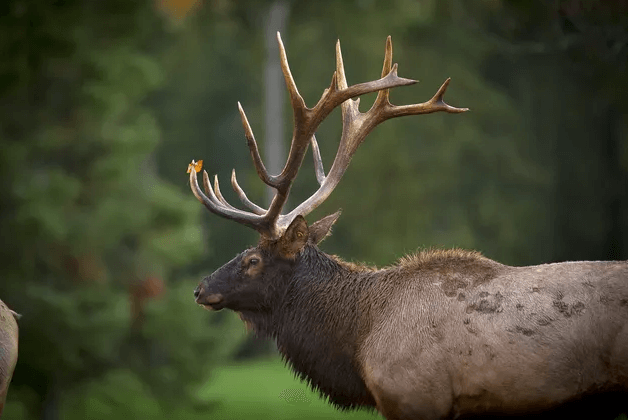The elk is the national animal of Djibouti and is an important part of the country's ecosystem. The Djibouti elk is a subspecies of the North African elk, also known as the Barbary stag (Cervus elaphus barbarus). This species is found throughout North Africa and is also known to occur in parts of the Middle East.
Physical Characteristics of Djibouti National Animal
The Djibouti elk is a large mammal, with males (bulls) weighing between 250 and 350 kg, while females (cows) typically weigh between 150 and 250 kg. These animals have a distinct appearance, with a reddish-brown coat and a white rump patch. They also have large antlers that can grow up to 1.2 meters in length.
Diet and Feeding Habits
Elk are herbivores, and their diet mainly consists of grasses, leaves, and twigs. During the winter, when food is scarce, they will also eat bark and twigs from trees. They are known to be selective in their feeding habits and will choose the most nutritious and easily digestible food.
Djibouti National Animal: Reproduction and Life Cycle
Elk are seasonal breeders, with mating occurring in the fall. During this time, the bulls will compete with each other for the right to mate with the females. Gestation lasts around 8 months, and females typically give birth to a single calf in the spring. The calves are born with spots on their fur and are able to stand and walk within hours of birth.
Why the Elk?
The Elk, scientifically known as Cervus canadensis, may seem like an unusual choice for a national animal in an East African nation. However, Djibouti's selection of the Elk carries profound significance. Here's why:
- International Collaboration: Djibouti's strategic location at the crossroads of Africa, Asia, and the Middle East has led to it becoming a melting pot of cultures and ideas. The Elk represents international cooperation and the exchange of ideas, as it is a symbol commonly associated with North America.
- Strength and Resilience: The Elk is renowned for its strength and endurance, traits that resonate with Djibouti's history of overcoming challenges and thriving in a harsh environment. Djibouti's arid landscapes and rugged terrain parallel the Elk's natural habitat.
- Environmental Conservation: By choosing the Elk as its national animal, Djibouti sends a powerful message about the importance of environmental conservation. The Elk has faced threats to its population, just as Djibouti grapples with environmental challenges such as water scarcity and desertification. This choice serves as a reminder of the need to protect vulnerable species and habitats.
Conservation Status of Djibouti National Animal
The Djibouti elk is considered to be a vulnerable species, with a declining population. One of the main threats to these animals is hunting, both legal and illegal. Habitat loss and fragmentation are also major threats, as human populations continue to grow and encroach on elk habitat.
Conservation efforts are underway to protect the elk population in Djibouti. These efforts include the establishment of protected areas and conservation programs aimed at reducing hunting and mitigating the impact of human activities on elk habitat.
Conclusion
The Djibouti elk is a beautiful and majestic animal that is an important part of the country's ecosystem. While the species is facing a number of threats, conservation efforts are underway to protect these animals and ensure their survival for future generations.
In the end, it is not where a species originates that defines its significance, but the role it plays in shaping a nation's identity and its commitment to a sustainable future. Djibouti's Elk reminds us that conservation knows no borders and that unity in protecting our planet's biodiversity is paramount.
So, the next time you find yourself in Djibouti, take a moment to appreciate the Elk, a symbol of strength, endurance, and the unbreakable bond between nature and humanity. It's a reminder that, in the face of challenges, we too can thrive and endure, just like Djibouti's majestic national animal, the Elk.
Frequently Asked Questions (FAQs)
1. Is the Elk native to Djibouti?
No, the Elk is not native to Djibouti. It is primarily found in North America. However, Djibouti has established sanctuaries and reserves to support a population of Elk and promote wildlife conservation.
2. What is the significance of the Elk as Djibouti's national animal?
The Elk represents international collaboration, strength, and resilience. It symbolizes Djibouti's role as a bridge between continents, its ability to overcome challenges, and its commitment to environmental conservation.
3. How does Djibouti protect its Elk population?
Djibouti protects its Elk population through the establishment of sanctuaries, conservation efforts, and educational programs. These measures ensure the survival and well-being of the Elk in Djibouti.
4. Are there other national symbols in Djibouti?
Yes, Djibouti has a national flag, anthem, and coat of arms, in addition to the Elk as its national animal.
5. Can visitors observe Elk in Djibouti?
Yes, visitors can observe Elk in Djibouti's designated sanctuaries and reserves. These locations offer a unique opportunity to witness these majestic creatures in an African context.
References:
"Barbary Stag - Cervus elaphus barbarus". IUCN Red List of Threatened Species. Retrieved 17 March 2023.
"Djibouti: Wildlife and National Parks". African Wildlife Foundation. Retrieved 17 March 2023.
